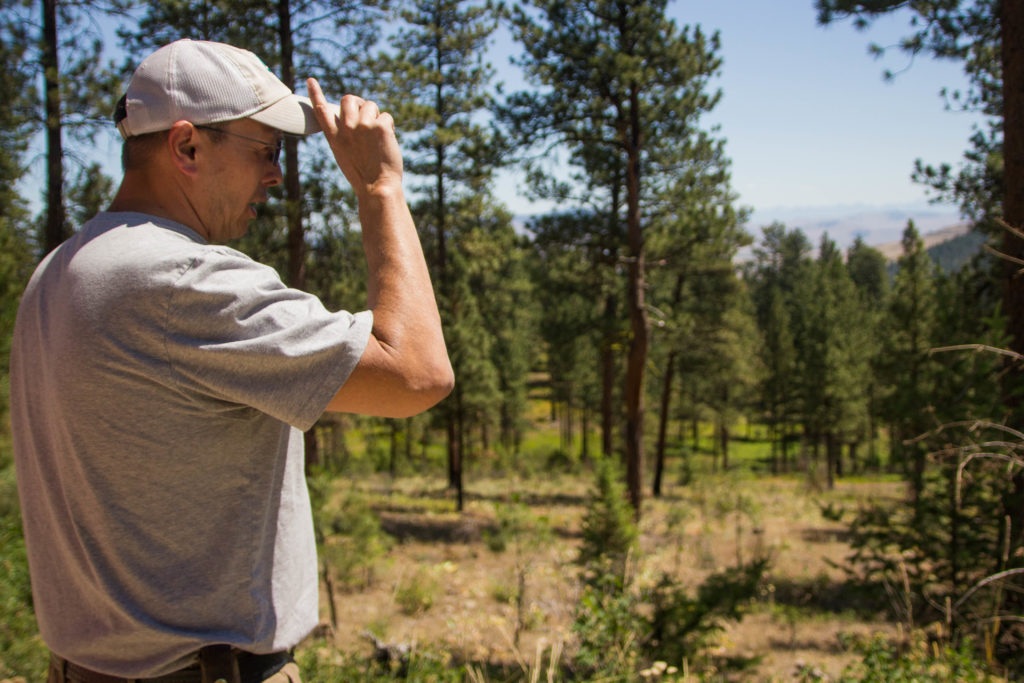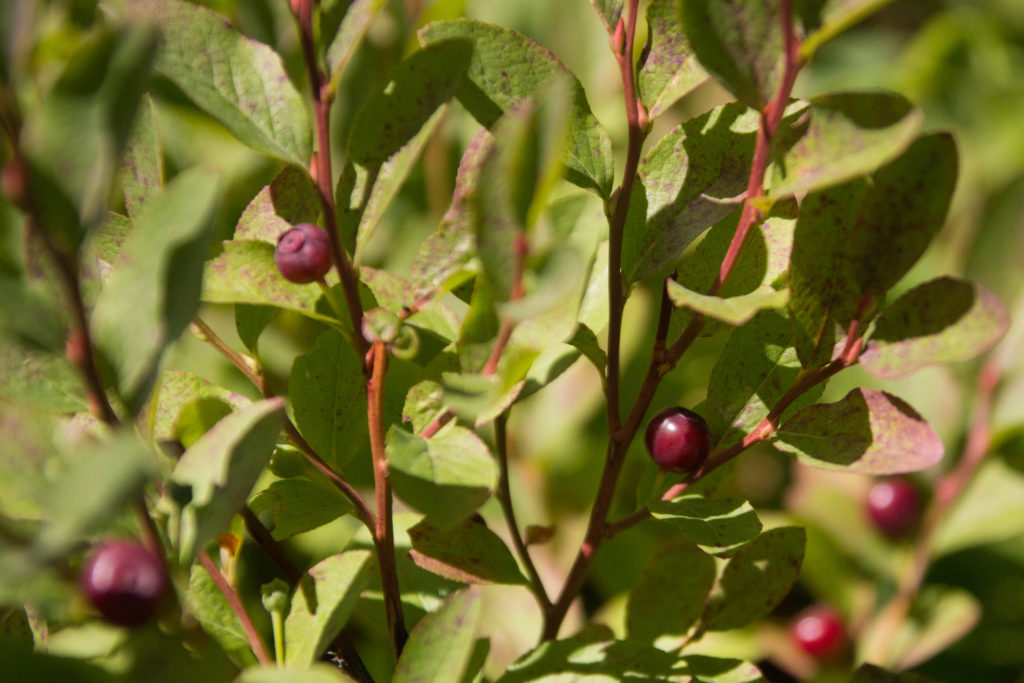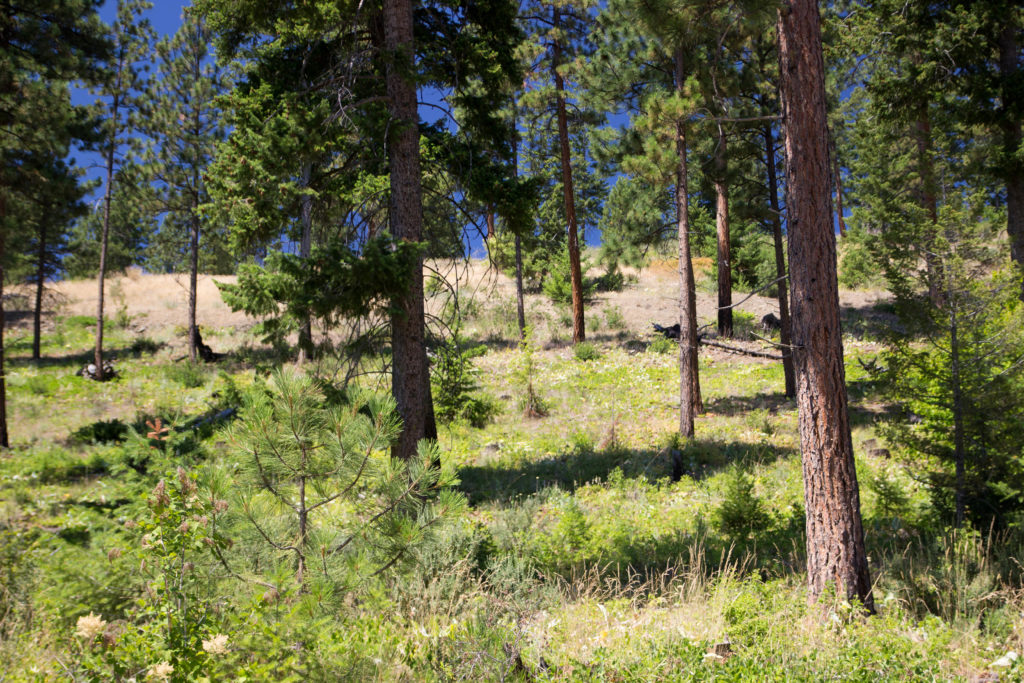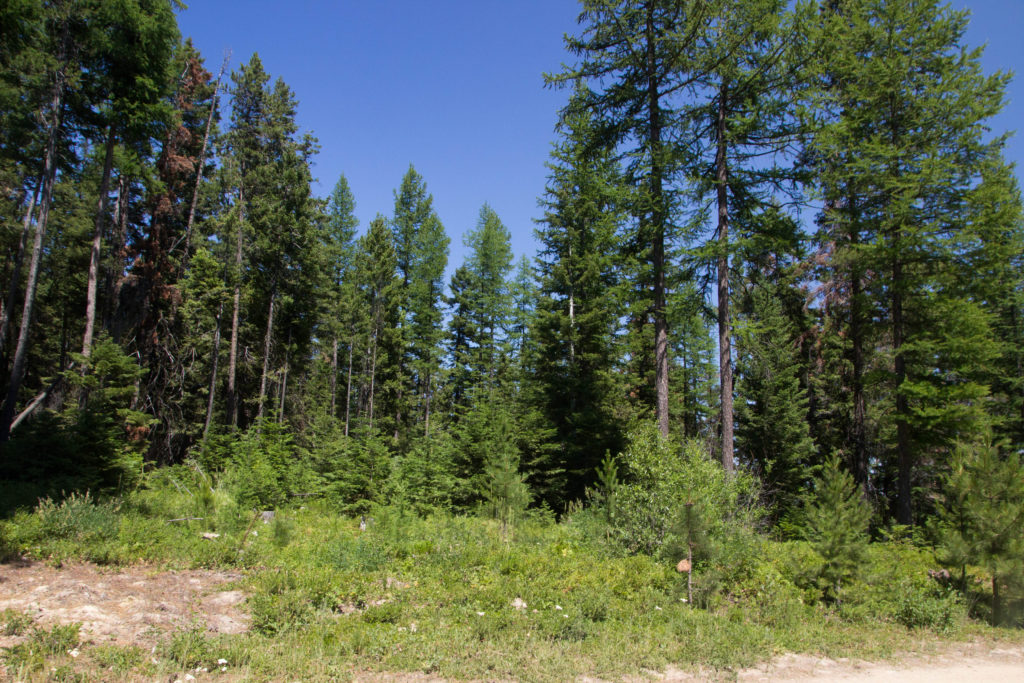
FLATHEAD RESERVATION, Montana – Art Trahan picked a huckleberry and popped it into his mouth, surveying the forest around him. To Trahan, a veteran fire technician and firefighter for the Confederated Salish and Kootenai Tribes Division of Fire, the legacy of fire is clear in the Garden Creek area of the Flathead Indian Reservation in western Montana.
This forest has seen multiple prescribed burns under CSKT management, and forest growth is indicative of that. Mature ponderosa pine trees tower above younger ponderosa and western larch. Huckleberry and buffaloberry bushes intermingle with other bright green foliage in the underbrush.

“[Huckleberries] like fire,” Trahan said. “Initially they’re knocked back a bit, but in five to 10 years they really produce berries.”
Trahan walks through the relatively open forest, stooping to pick more huckleberries and examine a small, three-year-old ponderosa seedling. Some tree trunks around him bear charred scars of fires past, but Trahan said trees that survive fires become more resilient.
“I know that it can be ugly,” Trahan said. “But it’s not necessarily a bad thing.”
Wildland fires that burn through here may have flames that reach two or three feet high, Trahan said. The large, established pines barely feel a thing, and firefighters like Trahan can more easily manage the lower-intensity flames.
A little ways down the road is an unburned area.
Here, the forest is a veritable thicket. The underbrush is choked with bushes and young trees. Visibility is all but gone, and a walk through the forest becomes a chore. When the dry season comes, parched plants must compete for water with more neighbors. The wildland fires in these areas burn hotter, devouring the fuel-packed forest. Trahan said 200- to 300-foot flames kill everything, even decades- and centuries-old pines.
During a time when fire is feared, western Montana tribes work to apply more fire to the ground, just as their ancestors did for thousands of years. These tribal managers integrate historic tribal knowledge with modern practices, a challenge complicated by a history of fire suppression, land ownership and climate change.

**
Each Indian tribe in the U.S. has its own fire traditions. The Bitterroot Salish, Pend d’Oreille and Kootenai tribes burned for more than 7,000 years in areas of modern-day Idaho, Montana, Wyoming and British Columbia. Today, these tribes reside on the Flathead reservation in western Montana and are collectively known as the CSKT.
The CSKT actively curate and share their histories, including fire traditions. One such effort produced the Fire History Project, completed in 2005. (See accompanying story.) Project Director Germaine White, information and education coordinator for the CSKT Natural Resources Department, said the tribes themselves are most qualified to tell their own fire histories.
“Tribal people have tremendous depth of knowledge and experience in tribal use of fire,” White said.
In 2000, the CSKT completed the Flathead Indian Reservation Forest Management Plan, the first of its kind. It incorporates a holistic ecosystem approach to forest management, considering the health of the entire forest in addition to timber production. The plan also outlines education goals to help residents and visitors learn about holistic management practices and non-timber uses of forest goods.
CSKT tribal forestry manager Jim Durglo said with this holistic approach, the tribes see themselves as caretakers who must treat the land and its gifts with respect.
“Tribes look at other resource values and cultural use a lot more than, say, technical forest management,” Durglo said. He added that modern research and timber goods are also important factors in tribal management.
Durglo said tribes on the Flathead reservation today apply fire to the land for the same reasons outlined in the Fire History Project. Fires ease hunting and gathering, open forest lands and sweeten grasses for grazing herds. But the legacy of fire suppression makes putting fire on the land even more important: It reduces the harmful accumulation of fuels in forests that contribute to devastating wildland fires.
Putting fire on the land is not an overnight process, however. Durglo said the planning process alone can take up to two years.
Forestry and fire staff collect data and develop detailed plans with specific management objectives, such as managing for a timber sale or for a certain species of wildlife, like elk. An environmental assessment must be completed as part of the National Environmental Policy Act, though most prescribed fires on tribal lands fall under the less rigid categorical exclusion provision.
Finally, a timber sale contract is finalized, if applicable, and activity on the ground can begin. The Garden Creek area, for example, was initially managed for a timber sale. After logging, the tribes thinned some trees to open the forest up.
Fire managers then dig fire lines to contain the fire. Finally, fire technicians like Art Trahan light fires on the edges of designated parcels while a helicopter ignites central areas from the air. If all goes to plan, the fire will burn downhill and inward on the parcels, safely containing the fire.
But even within the same 5,000-acre landscape and careful preparation, fires can be unpredictable. Some parts of Garden Creek haven’t burned according to plan, often due to unfavorable weather conditions. While one parcel may have been burned multiple times, others haven’t been burned at all. Depending on the area, it can be five to seven years between prescribed burns, and up to 20 years between timber sales.

**
But managing fire in western Montana comes with even bigger challenges.
The CSKT must navigate a complicated patchwork of land ownership. Tribal, federal, private and state lands are intermixed in a checkerboard of management headaches.
Durglo said tribes sometimes choose to let a fire burn on tribal land, but they must extinguish fires on state land as per state policy. In addition, other stakeholders on these landscapes worry about unintentional consequences of fire, such as making a forest more vulnerable to invasive species.
CSKT land managers would like do more burns in the spring and winter, during “shoulder” seasons when plants respond differently to fire. But local air quality regulations often prevent such burns, as the smoke sometimes settles on top of a nearby community.
“We have goals to redevelop the forest structure and those pine savannahs, but I think the big issue is reintroducing fire and disturbance to the landscape that was there before,” Durglo said.
Durglo added the tribes are also considering the consequence of climate change. In their 2013 Climate Change Strategic Plan, the tribes acknowledge that climate change may produce longer, drier fire seasons that could result in increased risk of wildland fire. This plan outlines potential landscape scenarios as well as proposed responses.

**
CSKT Division of Fire Manager Ron Swaney walks the line between fighting fires and applying fire to the land. With an increased number of wildland fires, Swaney said he’s not sure if he or the general public would be ready for more prescribed burns.
In 1998, there were 32 wildfires on tribal land. Last year, there were more than 80. Fires seasons around the Flathead now run from May to October or November.
However, Swaney is hopeful and confident. In the last two years, Swaney said fire management has burned more acres than wildland fires have. And that’s the ultimate goal.
“That would be our ideal situation– we initially put fire into the environment in a controlled, deliberate approach to try to maintain low fire intensity and protect the cultural and tribal resources that we have,” Swaney said. “Knowing that sometime it’s going to burn and it’s probably going to burn in a way that we don’t like, we try to beat it to the punch with low intensity fires.”
In the past couple of decades, non-tribal land managers have started looking for ways to integrate traditional knowledge into their management practices. Traditional knowledge incorporates not only place-based knowledge of land and climate, but also considers tribal beliefs and cultural values. In 2012 and 2015, two workshops in western Montana brought together tribal and non-tribal land managers to discuss the challenges and benefits of utilizing traditional knowledge in modern management practices.
Where western science often breaks ecosystems into separate, more manageable units, CSKT’s Forest Management Plan ascertains the tribes have always understood that decisions should be made holistically, with the understanding that everything in nature is connected, both to each other and to cultural values.
Now, western management is playing catch-up.

**
Steve Pyne, author and a Regents Professor at Arizona State University, said applied-science management alone may not hold all the answers.
“All of the bad practices we did had the science of their day behind them,” Pyne said. “We’re getting to a position now where science is not going to inform. Science is going to monitor and measure and tell us how our decisions are working out.”
Pyne spent 15 fire seasons with the forest fire crew at the North Rim of the Grand Canyon. He’s learned to look at wildland fires from a bird’s-eye view.
Fire management is on the cusp of big changes, Pyne said, but some agencies like the U.S. Forest Service, may be slow to adopt those changes on a national level. The USFS has historically implemented science-applied management, and Pyne said it’s time for a change.
“What does it mean if science can’t answer the questions?” Pyne said. “Their whole identity as an applied science has to adjust. This is a huge shift for them.”
One of these shifts may be utilizing traditional knowledge. Tribes essentially conducted thousands of years of trial and error experiments, Pyne said, and that knowledge is valuable.
“Traditional knowledge is still empirical knowledge,” Pyne said. “We can learn from that. They succeeded, and we’ve largely failed.”
Collaboration between stakeholders and reaching out to current projects is the next step, Pyne said. Some programs in northern California and Australia have successfully integrated traditional knowledge into fire management plans. Parts of the southeast and midwestern U.S. have started to implement prescribed burns into management plans, but progress has been slower in the West.
Pyne said before agencies can implement real change, they must survive increasingly dangerous fire season. That will require every boot on the ground from every available agency.
Boots like Art Trahan, whose priority is the health of the forest. To Trahan, a healthy forest is a fire-resilient forest. He may see another three or four burns of the Garden Creek area in his lifetime, but it’s a long process. Trahan knows he might not be around to see the finished product, if such a thing exists.
“We’re doing good work and creating a healthier forest, something that’s a little more resilient to fire and rejuvenates all the plants,” Trahan said. “This will amount to my life’s work.”
Guday,
Same process applies for Quandamooka tribal country on Minjerribah
in Australia.
Quandamooka Yoolooburrabee Aboriginal Corporation are returning to cultural fire to return health to landscapes containing 1500 year old tree assemblages which are a product of cultural use of fire for 20000 years plus.